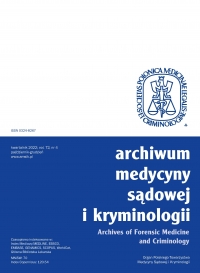Development of a procedure involving artifact examination to determine the species affiliation of its biological material, as illustrated by an attempt to demystify an alleged Nazi lampshade made from human skin
Development of a procedure involving artifact examination to determine the species affiliation of its biological material, as illustrated by an attempt to demystify an alleged Nazi lampshade made from human skin
Author(s): Maciej Trzciński, Anna Karpiewska, Agnieszka Hałoń, Anna Jonkisz, Arleta Lebioda, Tomasz Jurek, Tadeusz DoboszSubject(s): Criminology
Published by: Wydawnictwo Uniwersytetu Jagiellońskiego
Keywords: lampshade; forensic genetics; molecular biology; histology; human skin;
Summary/Abstract: Objectives: The main purpose of the study was to identify the species origin of the material from which the incriminating lampshade bought at a flea market had been made. Methods: The histological and molecular biology methods commonly used in forensic genetics were selected to achieve this goal. The DNA for the research was isolated using a QIAamp DNA Mini Kit (Qiagen) according to the manufacturer’s protocol for tissues. The quantitative and qualitative evaluation of genetic material was carried out by the real-time PCR method with a Quantifiler Duo DNA Quantification Kit (Applied Biosystems). Specific genetic markers of mtDNA of cattle, equines, deer, wild boar, and sheep were selected to identify species. Results: Histological tests showed that the lampshade had been made from intestinal flaps. The DNA from sample tested positive for cattle. The test results dispelled the suspicion that the researched lampshade had been made from human skin. Conclusions: The proposed testing method can be used to verify the origin of the artifacts misleadingly described as made from human skin. To our knowledge, such artifacts can be found in museums and private collections. Further-more, it has been widely believed until now that human-skin products, mainly lampshades, were mass-produced in Nazi concentration camps, mainly in Buchenwald.
Journal: Archiwum Medycyny Sądowej i Kryminologii
- Issue Year: 72/2022
- Issue No: 4
- Page Range: 223-231
- Page Count: 9
- Language: English

